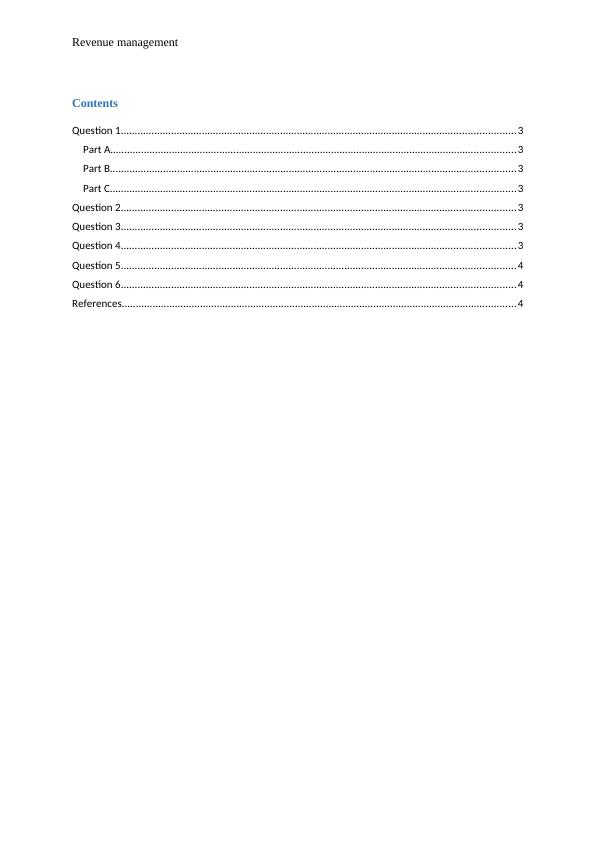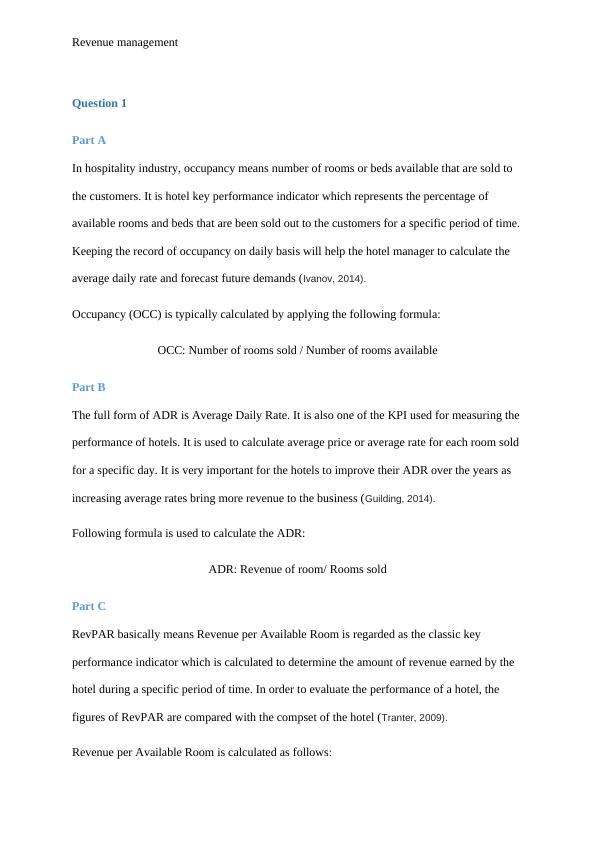Revenue Management Strategies for Hotels: Occupancy, ADR, and RevPAR
Added on 2023-06-11
11 Pages2699 Words217 Views
RUNNING HEAD: REVENUE MANAGEMENT
Revenue Management
Revenue Management

Revenue management
Contents
Question 1.............................................................................................................................................3
Part A.................................................................................................................................................3
Part B.................................................................................................................................................3
Part C.................................................................................................................................................3
Question 2.............................................................................................................................................3
Question 3.............................................................................................................................................3
Question 4.............................................................................................................................................3
Question 5.............................................................................................................................................4
Question 6.............................................................................................................................................4
References.............................................................................................................................................4
Contents
Question 1.............................................................................................................................................3
Part A.................................................................................................................................................3
Part B.................................................................................................................................................3
Part C.................................................................................................................................................3
Question 2.............................................................................................................................................3
Question 3.............................................................................................................................................3
Question 4.............................................................................................................................................3
Question 5.............................................................................................................................................4
Question 6.............................................................................................................................................4
References.............................................................................................................................................4

Revenue management
Question 1
Part A
In hospitality industry, occupancy means number of rooms or beds available that are sold to
the customers. It is hotel key performance indicator which represents the percentage of
available rooms and beds that are been sold out to the customers for a specific period of time.
Keeping the record of occupancy on daily basis will help the hotel manager to calculate the
average daily rate and forecast future demands (Ivanov, 2014).
Occupancy (OCC) is typically calculated by applying the following formula:
OCC: Number of rooms sold / Number of rooms available
Part B
The full form of ADR is Average Daily Rate. It is also one of the KPI used for measuring the
performance of hotels. It is used to calculate average price or average rate for each room sold
for a specific day. It is very important for the hotels to improve their ADR over the years as
increasing average rates bring more revenue to the business (Guilding, 2014).
Following formula is used to calculate the ADR:
ADR: Revenue of room/ Rooms sold
Part C
RevPAR basically means Revenue per Available Room is regarded as the classic key
performance indicator which is calculated to determine the amount of revenue earned by the
hotel during a specific period of time. In order to evaluate the performance of a hotel, the
figures of RevPAR are compared with the compset of the hotel (Tranter, 2009).
Revenue per Available Room is calculated as follows:
Question 1
Part A
In hospitality industry, occupancy means number of rooms or beds available that are sold to
the customers. It is hotel key performance indicator which represents the percentage of
available rooms and beds that are been sold out to the customers for a specific period of time.
Keeping the record of occupancy on daily basis will help the hotel manager to calculate the
average daily rate and forecast future demands (Ivanov, 2014).
Occupancy (OCC) is typically calculated by applying the following formula:
OCC: Number of rooms sold / Number of rooms available
Part B
The full form of ADR is Average Daily Rate. It is also one of the KPI used for measuring the
performance of hotels. It is used to calculate average price or average rate for each room sold
for a specific day. It is very important for the hotels to improve their ADR over the years as
increasing average rates bring more revenue to the business (Guilding, 2014).
Following formula is used to calculate the ADR:
ADR: Revenue of room/ Rooms sold
Part C
RevPAR basically means Revenue per Available Room is regarded as the classic key
performance indicator which is calculated to determine the amount of revenue earned by the
hotel during a specific period of time. In order to evaluate the performance of a hotel, the
figures of RevPAR are compared with the compset of the hotel (Tranter, 2009).
Revenue per Available Room is calculated as follows:

Revenue management
RevPAR = Rooms revenue / Number of rooms available21
Question 2
Following three key findings can be derived by properly analysing the STR reports of the
hotel:
1. By looking at the STR reports, it can be said that in terms of RevPAR, the hotel has
performed pretty well as its revenue for the week has increased by 25.5% whereas the
compset or the market has shown an increase of 3.3% only. Hence, it can be said that
the performance of the hotel in terms of its revenue per available room is satisfying.
2. Looking at the average daily rate, it is noticed that hotel’s ADR has shown a huge
reduction of 9.8% in the whole week. As compare to the competitors, their ADR is
reduced only by 3.4%. This reduction in daily rate has impacted the occupancy of the
hotels.
3. The occupancy of the hotel is greater than its competitors as it is reported at 91.8%
with an increase of 39.1%. This is because of the low ADRs during the week. Market
occupancy has shown only an increase of 6.9% because of the high daily rate of
$69.39. Hence, it can be said that the hotel has performed well as compare to its
compset.
From the above findings, it can be concluded that the overall performance of the hotel has
been satisfactory in terms of its occupancy and revenue as compare to the market. Friday and
Saturday are the two worst performing days for the hotel. On Friday, the occupancy of the
hotel reduces along with its ADR. As a result of which, the RevPAR of the hotel was very
much lower than the market’s RevPAR. However, the occupancy of the hotel was more on
Friday as compare to its competitor; still its revenue was less than other week days. Talking
about Saturday, the occupancy of the hotel do increases but it was lower than the market. The
RevPAR = Rooms revenue / Number of rooms available21
Question 2
Following three key findings can be derived by properly analysing the STR reports of the
hotel:
1. By looking at the STR reports, it can be said that in terms of RevPAR, the hotel has
performed pretty well as its revenue for the week has increased by 25.5% whereas the
compset or the market has shown an increase of 3.3% only. Hence, it can be said that
the performance of the hotel in terms of its revenue per available room is satisfying.
2. Looking at the average daily rate, it is noticed that hotel’s ADR has shown a huge
reduction of 9.8% in the whole week. As compare to the competitors, their ADR is
reduced only by 3.4%. This reduction in daily rate has impacted the occupancy of the
hotels.
3. The occupancy of the hotel is greater than its competitors as it is reported at 91.8%
with an increase of 39.1%. This is because of the low ADRs during the week. Market
occupancy has shown only an increase of 6.9% because of the high daily rate of
$69.39. Hence, it can be said that the hotel has performed well as compare to its
compset.
From the above findings, it can be concluded that the overall performance of the hotel has
been satisfactory in terms of its occupancy and revenue as compare to the market. Friday and
Saturday are the two worst performing days for the hotel. On Friday, the occupancy of the
hotel reduces along with its ADR. As a result of which, the RevPAR of the hotel was very
much lower than the market’s RevPAR. However, the occupancy of the hotel was more on
Friday as compare to its competitor; still its revenue was less than other week days. Talking
about Saturday, the occupancy of the hotel do increases but it was lower than the market. The

End of preview
Want to access all the pages? Upload your documents or become a member.
Related Documents
Occupancy in the hospitality sectorlg...
|12
|2959
|209
BHO3312 - Revenue Management, STR Reportlg...
|8
|2496
|129
Revenue Management Assignment (pdf)lg...
|12
|2493
|66
William Blue Hotel, Melbourne | Essaylg...
|6
|1529
|24
Revenue Management Assignmentlg...
|11
|2955
|125
(PDF) The key performance indicators (KPIs)lg...
|6
|1265
|193